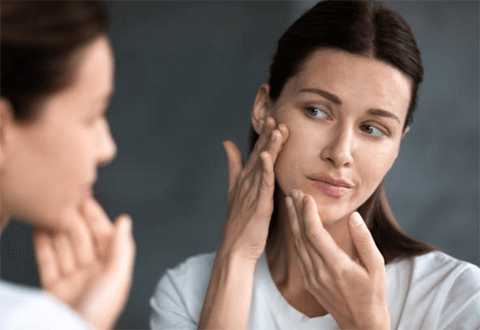We’ve long known that exposure to ultraviolet (UV) radiation from the sun can cause skin cancer, but a new poll shows that only about 30 percent of American adults say they’re concerned about developing skin cancer, even though nearly 70 percent have at least one risk factor for the disease. The survey conducted by the American Academy of Dermatology found that 49 percent of respondents were more worried about avoiding sunburn than preventing skin cancer; about 32 percent said they were more worried about avoiding wrinkles; and about 25 percent said they had been sunburned in 2020.
In addition to this worrying poll, it appears that the coronavirus pandemic may have caused delays in the diagnosis and management of skin cancer. An analysis of outpatient medical charts conducted by researchers at the National Society for Cutaneous Medicine found that in 2020, the total number of skin cancer diagnoses was lower than that of 2019. Extrapolated to the full United States population of approximately 330 million people, the investigators estimated that materially delayed initial diagnosis or treatment had affected over one million skin cancer cases. The delay in initial diagnosis and treatment may lead to skin cancers presenting at more advanced stages, with potential increased morbidity, as future data will show.
The most fatal kind of skin cancer, melanoma, is the fastest-growing. Additionally, it’s hard to detect with an untrained eye. In order to find any potential skin cancers that can’t be noticed with visual inspections, our tried-and-true skin-mapping system, developed exclusively by MoleMap, is built to probe deep inside a mole’s structure.
Skin cancer is the most common cancer both in the United States and worldwide, but when caught and treated early, the survival rates for skin cancer are extremely high. Despite this fact, one in five Americans will develop skin cancer by the age of 70, and more than two people die of skin cancer in the United States every hour.
For Tim Ioannides, MD, the key to fighting skin cancer is to ensure as many people as possible are educated on both what early signs may indicate skin cancer as well as tactics to prevent the disease from ever occurring in the first place. Dr. Ioannides began his career in dermatology working at a practice that mainly performed cosmetic procedures, but left in order to start his own practice, focusing exclusively on the medical side of dermatology.
With over 20 years of experience in the dermatological field and five practice locations in the Treasure Coast, below is the information Dr. Ioannides gives each of his own patients to educate them on skin cancer identification and prevention.
We know the cause
Age, a compromised immune system, a family history of skin cancer, or other hereditary variables are all factors that can affect a person’s risk for skin cancer, but the vast majority of cases are caused by exposure to the sun’s UV rays. 90 percent of nonmelanoma skin cancers are associated with ultraviolet radiation, and one UK study found that about 86 percent of melanomas can be attributed to the same cause. With this verified knowledge, Dr. Ioannides works with each of his patients to make sure they understand how unprotected sun exposure is not only damaging their skin and causing the wrinkles and age spots they hate but also making them more susceptible to skin cancer with each occurrence.
The sun emits three types of ultraviolet rays: UVA, UVB, and UVC. UVC rays have the shortest wavelength and are therefore completely absorbed by the ozone layer and atmosphere. However, UVB and UVA rays are long enough to reach the Earth’s surface and, as a result, are both able to penetrate our skin as well.
UVB rays are the shorter of the two wavelengths and are the primary cause of the skin’s reddening and inflammation, which we call sunburn. Exposure to UVB rays on your skin damages the DNA in your skin’s cells, causing your body to flood the damaged area with blood in order to help with the healing process, resulting in the characteristic red skin and pain to the touch.
UVA’s wavelengths are the longest of the three, meaning it is able to penetrate the deepest in the skin and damage the fibers known as elastin. This damage is what causes your skin to lose its elasticity, sag, stretch, bruise, tear more easily, and take longer to heal.
Because of this, UV radiation is included in Group 1 of the World Health Organization’s list of agents that are cancer-causing to humans, alongside plutonium and cigarettes. In addition to the cosmetic damage, such as sunburn and wrinkles, that UVA and UVB rays cause to the DNA within your skin cells, they also allow it to mutate. When the DNA mutates, it can no longer properly control skin cell growth, leading to an abnormal growth of skin tissue that we call a cancerous tumor.
By giving each of his patients a solid foundation on the cause of skin cancer, Dr. Ioannides helps them understand how easily skin cancer can sneak up on you. Knowing the facts—such as that having five or more sunburns doubles your risk for melanoma—may feel a bit scary, but it is vital to know how skin cancer occurs in order to diagnose it in a timely way.
The types of skin cancer
In tandem with teaching his patients about how the sun’s rays cause skin cancer, Dr. Ioannides also ensures that they are aware of the most common types of skin cancer, as well as their most common characteristics. While regular appointments with physicians can aid in the timely diagnosis of skin cancer, by learning what to look out for, you can increase your vigilance at home. However, Dr.Tim Ioannides notes that while there are common factors for each type of cancer, they can still look quite different from person to person, meaning one should keep an eye on any new or unusual growths on the skin.
While melanoma is not the most common form of skin cancer, it is one of the more dangerous forms due to its ability to spread to other organs quickly if it isn’t caught and treated early, and worryingly, the number of new invasive melanoma cases has been increasing over the past decade.
Between 2011 and 2021, the number of cases diagnosed annually increased by 44%. When detected early, the estimated five-year survival rate for patients in the United States with melanoma is about 99 percent, but once melanoma has spread deeper into the skin or other parts of the body, it can be deadly due to the difficulty of treatment.
There are four main types of melanoma, meaning it presents in many different shapes, sizes, and colors and is difficult to comprehensively categorize into clear warning signs; however, only 20 to 30 percent of melanomas are found in existing moles, while 70 to 80 percent arise on normal-looking skin.
Basal cell carcinoma is the most common form of skin cancer in the world, and over three million cases are diagnosed in the United States every year. Thankfully, this form of cancer rarely spreads beyond the original site of the tumor, but if allowed to grow, the lesions can become locally invasive, growing wide and deep into the skin and destroying the tissue and bone.
Additionally, there are still some highly unusual aggressive cases where basal cell carcinoma has spread to other parts of the body, and the longer you wait to have it treated, the more likely it is to recur. Lesions of basal cell carcinoma occur most often in areas that receive frequent sun exposure such as the face, scalp, ears, chest, arms, back, and legs.
They can look like open sores, red patches, pink growths, shiny bumps, scars, or growths with slightly elevated, rolled edges and/or a central indentation, and at times they may ooze, crust, itch, or bleed. About half of patients with darker skin have basal cell carcinomas that are brown in color.
An estimated 1.8 million cases of squamous cell carcinoma are diagnosed in the United States each year, making it the second-most common form of skin cancer. Like basal cell carcinoma, most squamous cell carcinomas are curable when caught early due to the slowness at which they spread to other parts of the body, but there are still aggressive types of them that target lymph nodes and other organs if left untreated.
Sun-exposed areas of the body are most susceptible to developing squamous cell carcinomas, and it is important to remember that this includes the back of your neck and even your lips. They can appear as scaly red patches, open sores, rough, thickened, or wart-like skin, or raised growths with a central depression, and they may crust over, itch, or bleed.
Conclusion
According to the authors of the study from the National Society for Cutaneous Medicine, there is likely still a large backlog of undiagnosed skin cancers since the coronavirus pandemic in 2020. More people are diagnosed with skin cancer each year in the United States than all other cancers combined, but the slow rate at which the most common skin cancers metastasize means that with timely diagnoses we can keep survival rates high. Ioannides MD’s practices are located in St. Lucie County, which has the second-highest skin cancer rate in the country, and he sees it as his responsibility to educate his community on the importance of early diagnosis when it comes to the disease.
Connect with Tim Ioannides MD on Medium and Thrive Global.



